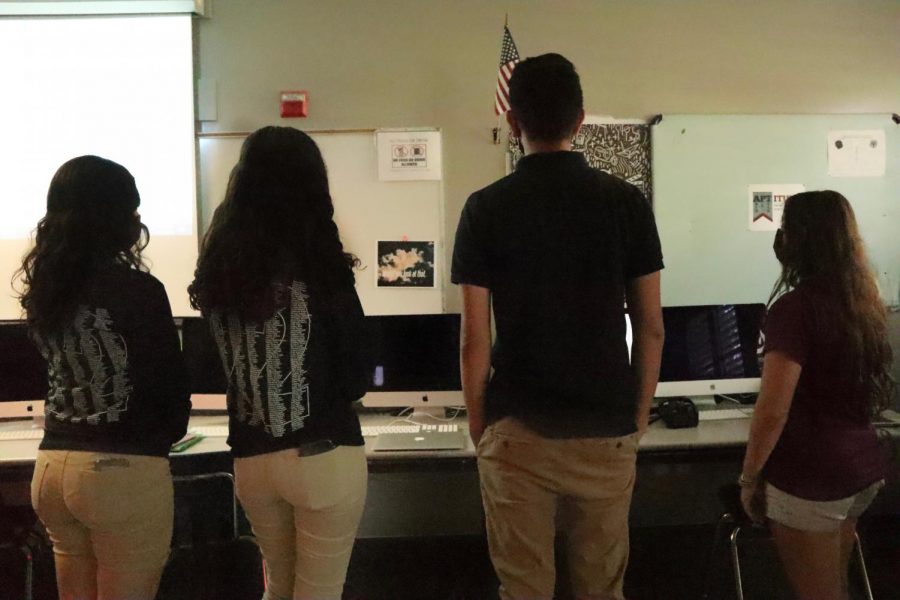A Moment of Silence: It’s Not What You Think it Is
September 3, 2021
Over the past few years, Florida Governor Ron Desantis has made a plethora of controversial decisions, many of which have directly affected the state’s education system. One decision, in particular, was guided by spirituality and religion: the new moment of silence.
Although public schools are prohibited from participating in group prayers under the Constitution, Desantis recognized a loophole in the system and has used it to implement the moment of silence, during which students are encouraged to exercise their religious and spiritual rights and reflect on themselves. Yet, despite participating in the minute-long break, not many students are familiar with the reason behind this new law. The lack of knowledge behind the decision has something to do with the lack of communication between teachers and students, as teachers are not permitted to suggest ways to spend the time. Instead, parents are encouraged to instruct their children on different topics they can reflect on.
With the new school year comes a variety of new rules and regulations that will have a large impact on the classroom: the moment of silence being one of them. By the second week of school, students have become accustomed to the familiar announcements that come over the P.A. every morning. As they stand for the pledge and continue standing for the moment of silence.
Even so, not many students know the main reason for this extra time. Some are under the impression that the moment of silence should be spent mourning those lost to Covid-19, whilst others believe that it is a time to briefly relax. While neither one of these sentiments is wrong, per-se, the official reason behind the law revolves around religion (Florida Phoenix). Regardless of the true intentions behind this new mandate, since actively expressing religion in public schools is prohibited, the mandate was presented to the public as a time to reflect and think (Moment of Silence). According to the Legislation, “in today’s hectic society too few persons are able to experience a moment of quiet reflection before plunging headlong into the activities of daily life. The Legislature finds that our youth will be well served if students are afforded a moment of silence at the beginning of each school day.” Despite how the law was presented Desantis stated, “The idea that you can just push God out of every institution and be successful- I’m sorry but our founding fathers did not believe that.” Among those that had different beliefs regarding the true intentions of the moment of silence is sophomore Mia Olmedo; even though she is indifferent to the rule, she too believed that it was meant to be a time where students reflect on the events that have occurred in the past year. “I don’t really mind if we have it or not. I originally thought that it was a time to think about what has happened with Covid. I don’t have a problem with it though.” she said. Sophomores Karly Acevedo and Lara da Costa nodded their heads in agreement with this statement, stating that they are indifferent to the rule as well.
In contrast to what many other students think, sophomore Dylan Scheer sees the benefits in the moment of silence: “It’s definitely a great time to reflect on how grateful you are to be here. It’s also a great time to remember your loved ones that could’ve passed away from complications,” he expressed. Sophomore Isabella Gonzalez understands Dylan’s perspective. Although she stated that she didn’t directly agree with either side, she said that she sees the rule as potentially beneficial: taking a momentary pause amidst a busy day. Some students argue that the time to reflect is at home rather than in the classroom, among those is Freshman Katia Borden. Although she stated that she doesn’t have a problem with it, she does feel that the moment of silence is a bit unnecessary. She feels that students can reflect and take a moment of pause at home instead of in the classroom. Although mindfulness and freedom of expression is an important idea to consider, whether school is the right place for it is certainly a controversial issue.
Contrary to other opinions, junior Amanda Vasquez has suggestions regarding the moment of silence, and states that “…I think it would have more of an impact if it wasn’t during homeroom because everyone is usually calm and doing their own thing.” In regards to the specific time for the moment of silence, both Katia and Amanda raise an interesting question: is first period the best time for reflection?
Regardless of your beliefs on the moment of silence: if it is beneficial or not, necessary or unnecessary, the rule is here to stay. Whether students use the time in a religious way, as a way to take a break amidst their busy schedule, or simply as a time to stare blankly into space, the controversial issue has certainly been one that has raised varying opinions. Masks, social distancing, the moment of silence… The new list of rules leaves students wondering; what else is in store for the 2021-2022 school year?





![Junior live streamers and Varsity Football players: Josiah Knight [left] and Jahsai Juste [right] posing together for a picture before their home game against North Miami High School on Friday, September 12th.](https://ppchsnews.com/wp-content/uploads/2025/09/Adobe-Express-file-300x206.jpg)

